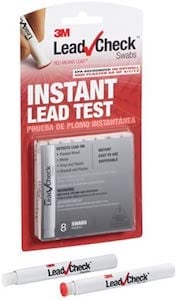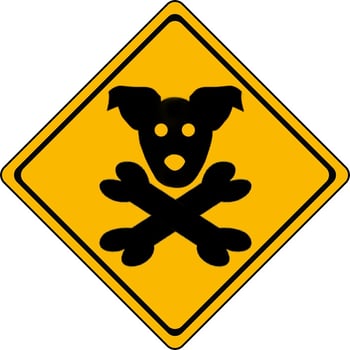 You may have read scary reports about toxins such as lead turning up in dog toys or shady manufacturing processes for dog chews and toys brought in overseas from places like China.
You may have read scary reports about toxins such as lead turning up in dog toys or shady manufacturing processes for dog chews and toys brought in overseas from places like China.
But there's one thing you probably haven’t heard: How do you tell whether the dog toy you just bought, or are about to buy, might be toxic?
The simple reason why is when it comes to toys designed specifically for dogs (and pets in general), there isn’t the same oversight and strict regulation that you might find in, for instance, children’s toys. In fact, one of the main benchmarks that would require testing for a dog toy is whether a child might come into contact with it.
So that’s the bad news. The good news is that there are resources, tricks, and specific products that can help you ensure the toys you give your dog will probably be safe for them to bite, chew, and chase.
In this article, you will learn how to check whether a dog toy might have potential toxins or even potentially toxic levels of naturally occurring elements (e.g., lead), as well as the different types of potentially dangerous elements, compounds, and chemicals that could be in your dog’s toys.
Looking for safer toy and chew recommendations? Check out our top picks in The Best Dog Chews and Toys.
How to Check a Dog Toy for Potential Toxins
• Be especially cautious of dog toys that are manufactured overseas if you can’t verify what’s in them — and even cheap toys that are manufactured in the U.S.• Check your product against the FDA’s list of recalled and withdrawn products.
• Ask the manufacturer about the presence of PVC, phthalates, BPA, lead, chromium, melamine, arsenic, bromine, and formaldehyde.
• If you suspect problems with a toy and your dog is behaving strangely, bring them to the vet, along with the toy, for evaluation or testing.
Who Regulates Dog Toy Safety?
No one. Next question.
OK, maybe that’s not a satisfying answer. But it’s an unfortunate truth when it comes to toxins in dog toys. We reached out to the U.S. Food and Drug Administration (FDA) for answers about dog toy safety regulations. Specifically, we asked the FDA’s Center for Veterinary Medicine, which said that the FDA regulates drugs, devices, and feed given to “companion and food-producing animals.” However, neither that agency nor any government or non-government organization regulates any of the following:
- Pet accessories like toys, beds, and crates
- Grooming aids
- Cat litter
- Bedding for pet birds and small animals, such as rabbits, guinea pigs, and hamsters
The FDA referred us to the American Pet Products Association (APPA), which responded by email, saying that “the Association is not a regulatory body; therefore, we are not in a position to offer advice to consumers on this topic.”
Of the agencies and organizations we reached out to, all of them recommended that consumers contact the manufacturers themselves to ask about the manufacturing process. But if you’re trying to figure out whether something is safe to give to your dog, it’s not always practical (or easy) to contact or get a quick response from the manufacturer. When we attempted to contact manufacturers, they were responsive, but it took about 24 hours, on average, to receive a response. Only one company gave its assurance that the products were safe, another provided actual testing results, and another simply didn't respond.
- A customer service rep from PetSafe (manufacturers of the Busy Buddy® Bouncy Bone) said they do not have testing results available, but assured that “all of our pet toys go through the same safety testing and regulations as toys intended for infants.”
- We called Multipet (which is one of the first results for "rubber dog toy" on Amazon) and were told to send an email. A Multipet representative responded that "Pet toys that warrant (based on their structure ) are tested and analyzed for toxins against Phthalate Analysis including Lead content with reference to CPSC (Consumer Product Safety Commission) directive." Multipet even sent a sample test report for the Magic Block Hair Brush, which you can view here.
- We reached out by email to Petmate (makers of Chuckit!) but received no response.
Fortunately, there are other resources available to help you research your dog's toys.
 How to Check if a Dog Toy Contains Toxins
How to Check if a Dog Toy Contains Toxins
Though there isn’t an all-encompassing database for all types of pet products, there are some resources you can use to find out what chemicals and compounds might be in a dog toy.
Healthy Stuff, a project of The Ecology Center, used to have an online library of test results for many brand-name pet products. Their tests contained results for things like chlorine, chromium, arsenic, bromine, cadmium, tin, antimony, mercury, and lead. The Healthy Stuff team ran their tests, and they uncovered a few surprising facts:
- 45% of products had detectable levels of hazardous toxins
- 48% percent contained detectable levels of lead
- About half of the products had lead levels higher than the allowable standard for children’s toys
(Read “Beware of Lead and Toxic Toys” to learn more about the test results.)
The FDA also maintains a searchable list of livestock and pet products that have been recalled or withdrawn from the market. The list is rather small, but it's good to check — just in case.

Alternatively, if you want to go the DIY route, the Environmental Protection Agency has a recommendation for consumers. The 3M Instant Lead Test is mostly used to test for lead on painted surfaces, but the website states it detects lead on “most surfaces.”
If you still can’t find an answer and really want to be sure, you can send the product in for testing. Just know that this will be expensive and time-consuming, and you will only be able to test for a few compounds, like lead. If you’re interested in doing so, the APPA has a list of test laboratories for pet products. Again, it's expensive — the one we reached out to charged $250 to test for BPA alone and as much as $525 for phthalates.
Chemicals That Are Potentially Toxic to Dogs
In 2007, Consumer Affairs revealed that it had found “elevated levels” of lead, chromium, and cadmium in two Chinese-made pet toys sold at Wal-Mart1. The dog toy tested at 1 part per million for lead, leading Consumer Affairs to the conclusion that “if a dog is chewing on it or licking it, he’s getting a good source of lead.”
And this is especially true the longer a dog gnaws on or licks the toy, as the lead was also “leaching” out of the toys, meaning that the lead could then be swallowed with the dog’s saliva and be absorbed into the bloodstream through the gut, even if the dog didn’t swallow pieces of the toy itself.
Toxins That Might Be Present in Dog Chews and Dog Toys
- PVC: Polyvinyl chloride (PVC) by itself is generally not dangerous to dogs, but manufacturers often use toxic chemical additives to make the PVC more soft and flexible.
- Phthalates: An additive often used in PVC products. Over time, they can leach out and absorb through the skin (like your dog’s gums) and cause damage to their liver and kidneys.
- BPA: Bisphenol A is an endocrine-disrupting chemical, and “the presence of BPA in dogs was associated with changes to their gut microbiome and metabolism,” according to Time.
- Lead: Can damage multiple organs, including the nervous system and gastrointestinal tract. Signs of lead poisoning in dogs might include a lack of appetite, diarrhea, constipation, anxiety, hysterical barking, jaw-champing (rapid clenching), salivation, blindness, lack of coordination, or muscle spasms. Note that some brands of tennis balls have had lead contamination problems in the past.
- Chromium: Though chromium has been used as an insulin supplement2 for dogs (among other uses) high enough levels can be toxic and have been shown to cause cancer in humans3.
- Melamine: Has been linked with kidney failure from pet foods that were recalled due to the presence of melamine.
- Arsenic: Heavy metal mineral that can lead to symptoms such as vomiting and loss of consciousness, and even death in extreme doses.
- Bromine: A chemical often used as a pet-safer alternative to chlorine in pools, but it can cause digestive upset and changes to urination.
- Formaldehyde: Formaldehyde is commonly used to preserve chews such as rawhides. With long-term exposure or high enough doses, it could cause problems for dogs, including possible respiratory or digestive irritation.
When Do These Chemicals Become Toxic?
Keep in mind that there are no officially accepted safety standards for the concentrations of these things in pet products, and experts will disagree about the amount at which they become dangerous for dogs, aka the “threshold.” Lead is most often a problem in paint, which can present a serious danger if your dog eats lead paint chips (lead paint wasn't banned in the U.S until 1978).
Charlotte Flint, Senior Consulting Veterinarian for Clinical Toxicology at Pet Poison Helpline & Safety Call International, said in an email that "toys and chews are not a common source of lead poisoning in dogs and cats, but occasionally lead is found in unexpected places such as imported toys, antique children’s toys, and toy jewelry for children."
“Puppies and kittens are more sensitive to the effects of lead as compared to adult dogs and cats,” Flint said. “Signs of lead poisoning in pets include vomiting, decreased energy and appetite, weight loss, as well as neurologic signs like seizures, tremors, and uncoordinated movements. On bloodwork, significant changes in the number and/or appearance of red blood cells can also be seen.”
When it comes to BPA and phthalates, Flint said the “toxic significance” for pets is “not clear currently.” Fortunately, some pet toys specifically call out on their packaging when they’re free of BPA and phthalates making it easier for you to avoid them, unlike lead.
 Important Contributing Factors to Toxins and Dogs
Important Contributing Factors to Toxins and Dogs
For toxins, it’s all about the exposure and dosage. After all, many human foods contain some level of arsenic, but that doesn’t mean those foods are toxic. There’s a big difference between the presence of a potential toxin and a toxic dose.
While we don't know the "threshold" for toxins in pet toys, we do know the toxic blood levels of many chemicals and compounds. For example, it's considered lead poisoning in dogs if they have a blood-lead concentration of .35 parts per million, 10 parts per million in the liver, and 10 parts per million in the kidney.
When it comes to toxins and dogs, the most important factors that could lead to a toxic level of any given chemical include:
- Presence: Does the manufacturer state or test for levels (concentrations) of toxins in their products?
- Exposure: What type of product is it? There’s more chance of a toxin reaching a problematic level within a dog’s bloodstream or other internal organs (like their liver, kidneys, nervous system, etc.) if it’s a product that’s meant to be eaten as opposed to chewed, unless it’s a compound that can leach out of the toy as it’s chewed or licked. Likewise, toxins in a water bowl are more likely to leach out (since the water will be in contact with the bowl for long periods of time) and enter your dog’s system.
- Physiology: What might be a toxic dose for a small dog might be relatively harmless for a much larger dog. Similarly, an older dog might be more at risk than a young, healthier dog.
If you're unsure whether a toy you've recently purchased for your dog is safe, do not give it to your dog. You can return it to where you originally purchased it or throw it away — but it's always best to err on the safe side when it comes to something your dog is chewing on.





